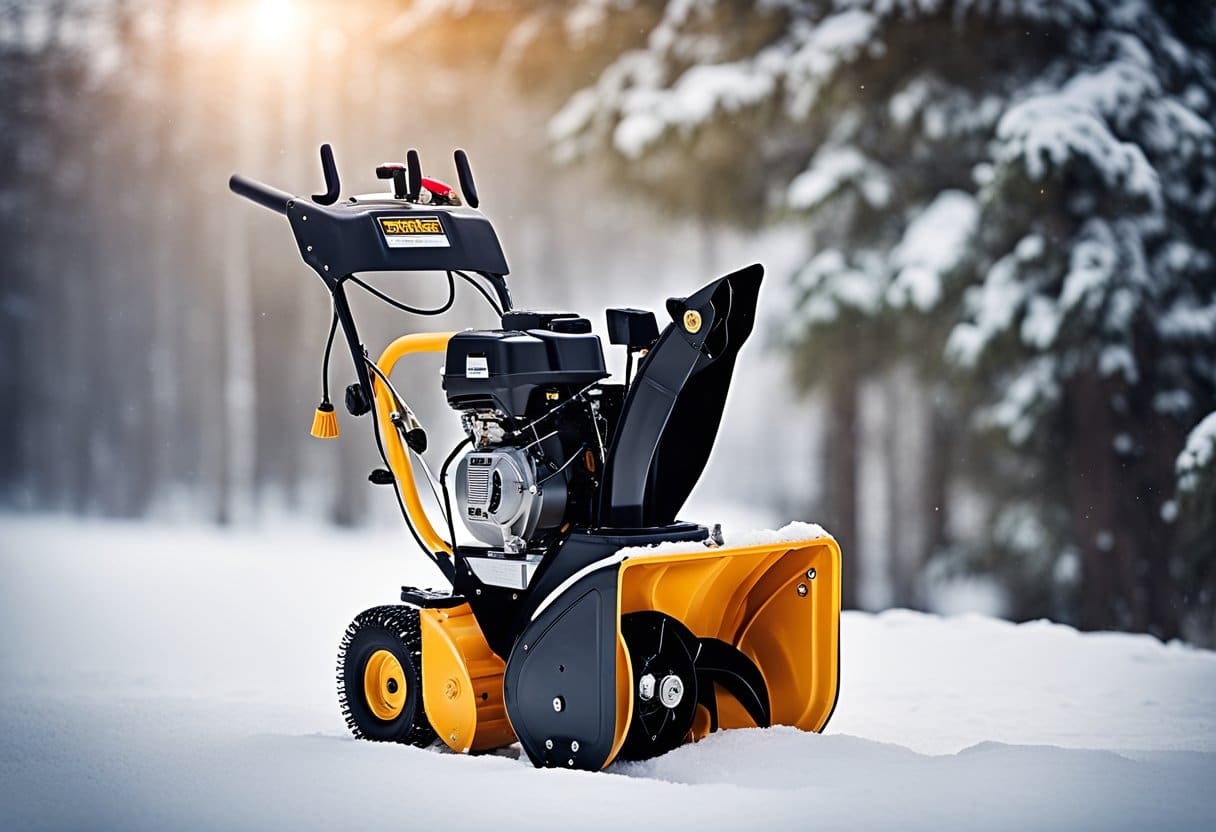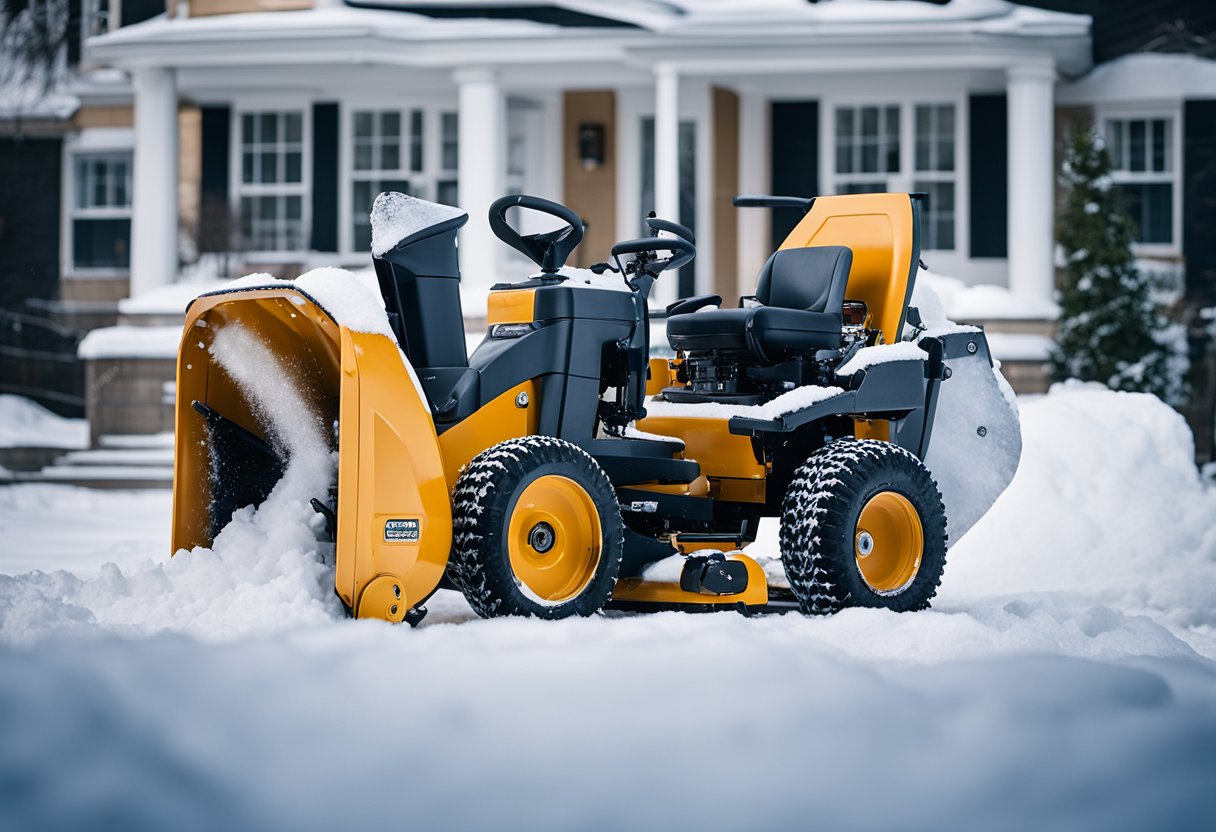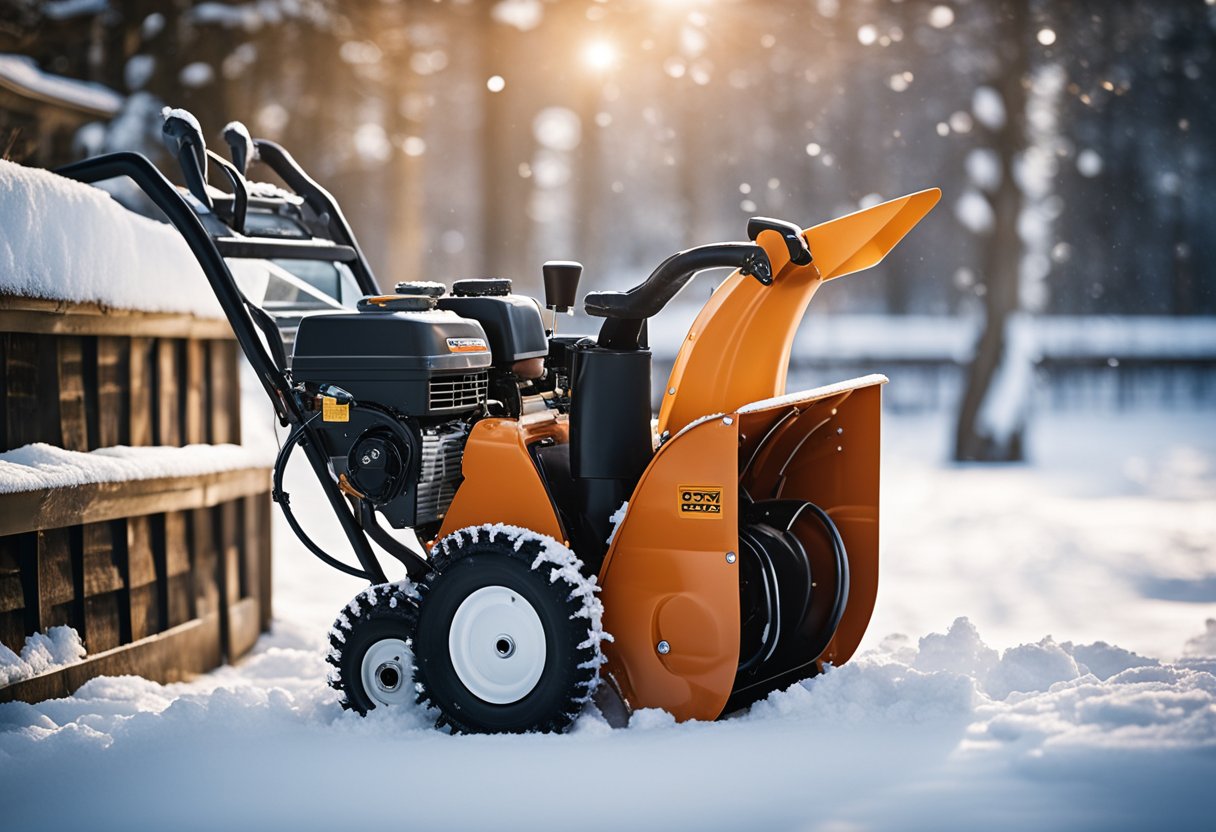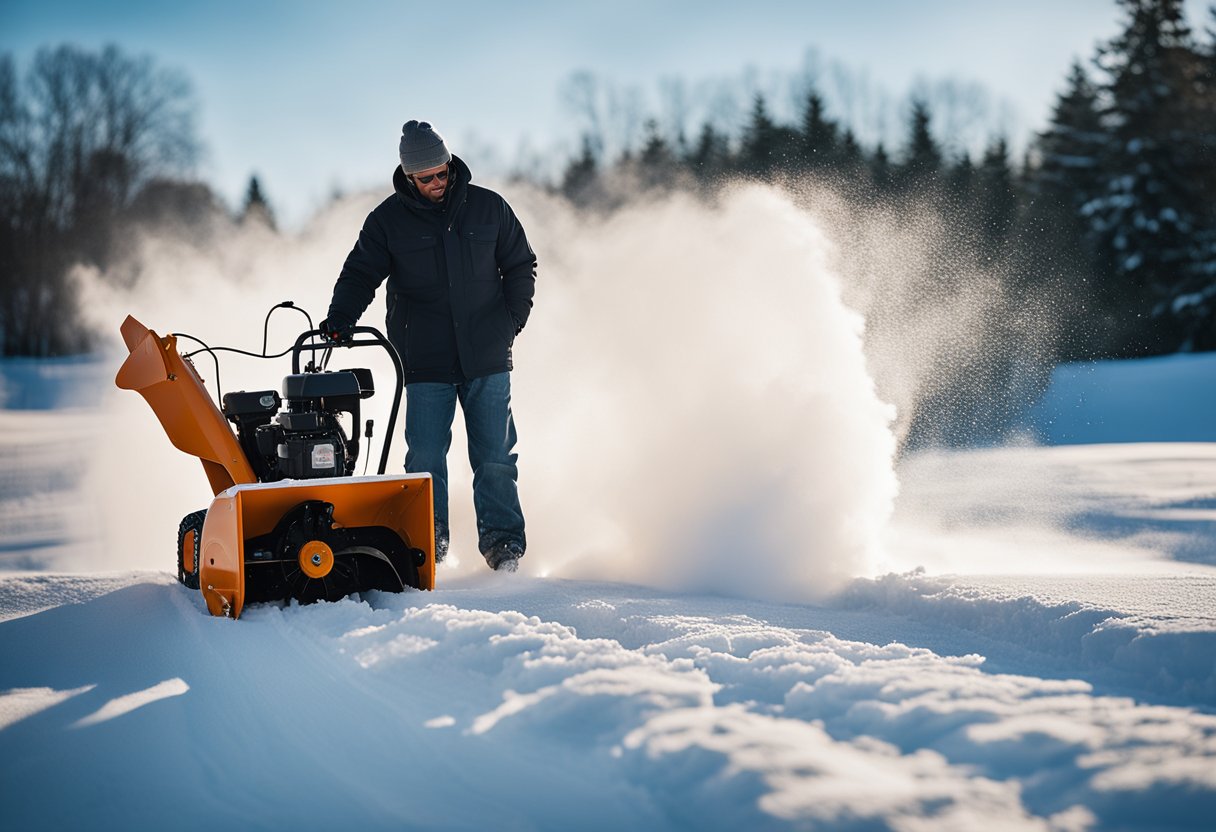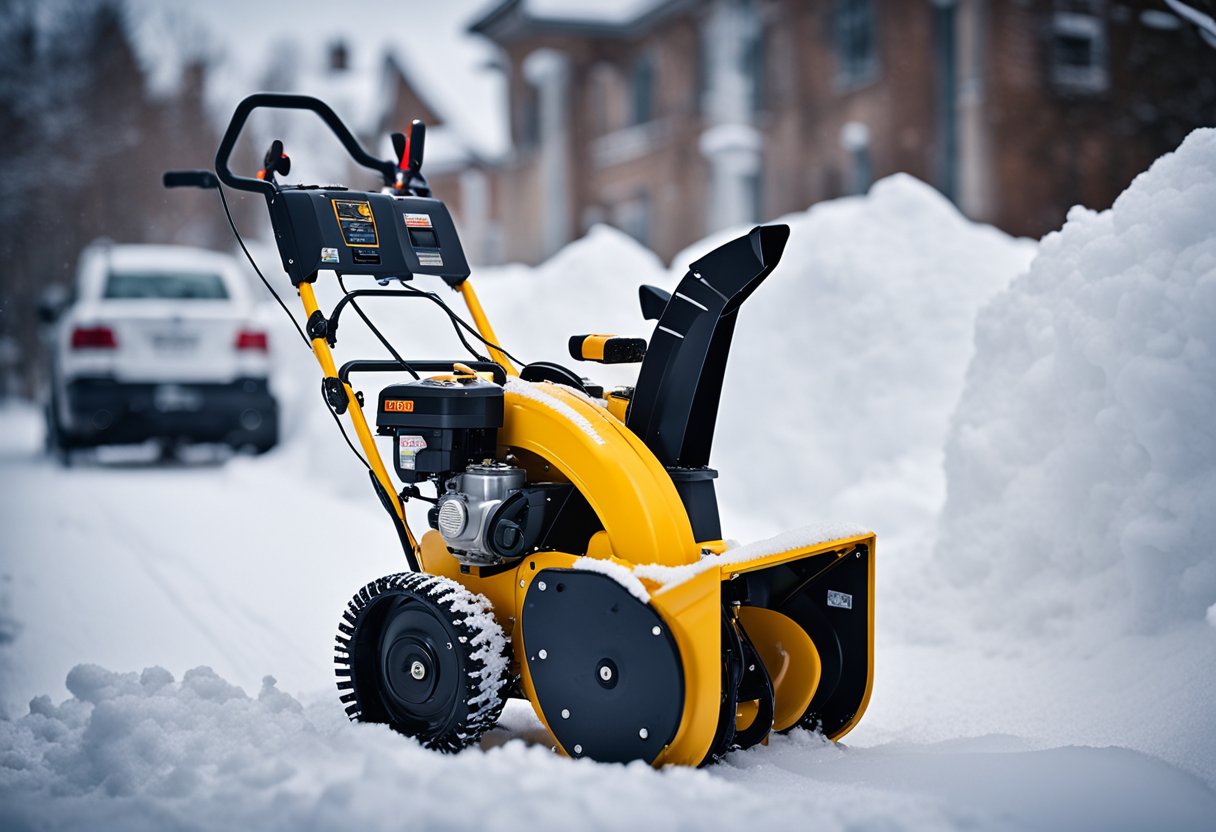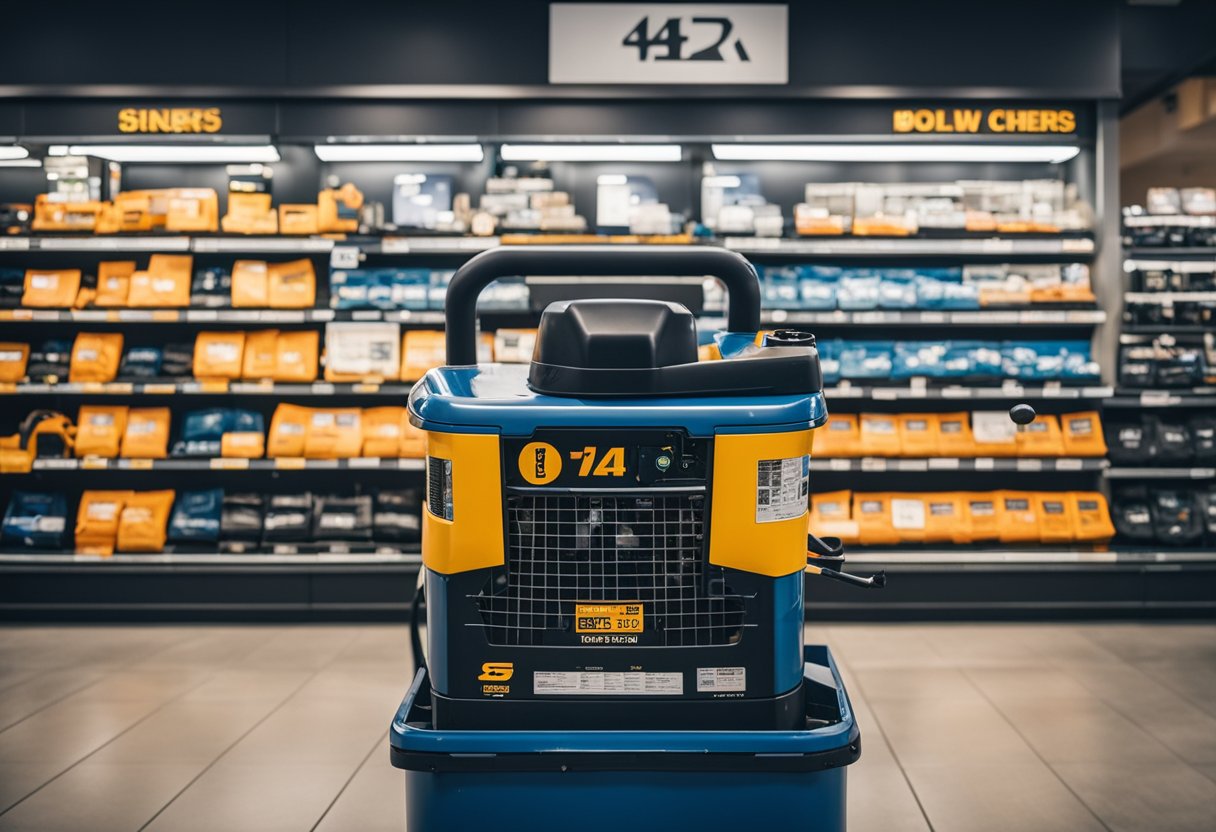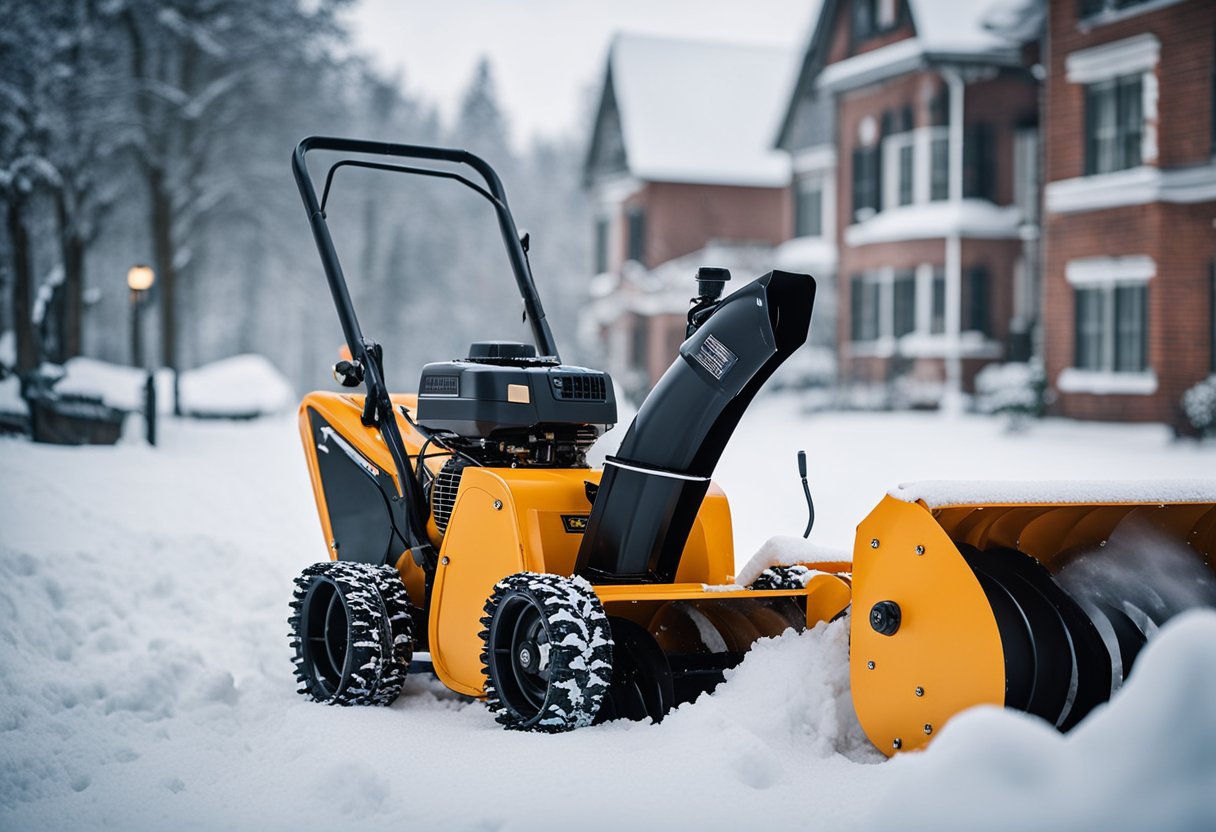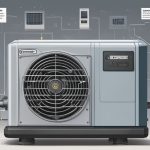Winter can be a beautiful and magical season, but for many homeowners, it also brings the tedious chore of snow removal. Investing in a snow blower can make clearing driveways, sidewalks, and other areas around your home more manageable, efficient, and even enjoyable. With a wide array of snow blowers on the market, it’s essential to determine which type suits your specific needs, preferences, and the average snowfall in your area.
Understanding the different types of snow blowers, as well as the key features to look for when purchasing one, will help you make the best decision for your situation. Factors such as performance, safety, and ease of use are also crucial when selecting the perfect snow blower for you. Lastly, it is essential to research top-rated models, consider the timing of your purchase, and learn how to maintain your investment properly to ensure it serves you well for years to come.
Key Takeaways
- Choose the right type of snow blower based on your needs and average snowfall.
- Consider both performance and safety when evaluating various models.
- Proper maintenance and timing of your purchase can ensure a long life for your snow blower.
Understanding Different Types of Snow Blowers
Snow blowers come in a variety of types and sizes, each with its own set of features designed to tackle different snow removal needs. Among the most common types are single-stage, two-stage, and three-stage snow blowers.
Single-stage snow blowers are the most basic and affordable option. They are usually compact and lightweight, making them suitable for smaller driveways and sidewalks. These machines use a single auger to both scoop up the snow and throw it out through a chute. Generally, single-stage blowers can handle snowfalls of up to 8-12 inches. However, their height limitations make them less effective for deeper snowdrifts. Most single-stage models are either gas-powered or cordless electric.
Two-stage snow blowers are larger and more powerful than their single-stage counterparts. They have a separate auger for breaking up and collecting the snow, as well as an impeller that propels the snow through the chute. This two-stage process allows them to handle heavier and deeper snowfalls, typically up to around 24 inches. Gas-powered engines are the standard for this type, ensuring sufficient power and performance for tackling bigger jobs.
Three-stage snow blowers are the most powerful and efficient option, designed to handle the most challenging snow removal tasks. In addition to the standard auger and impeller, these models also feature an accelerator that helps break up compacted snow and ice before it enters the impeller. This makes three-stage snow blowers capable of clearing even the most stubborn snowdrifts and icy terrain. Like two-stage models, they are generally gas-powered.
When choosing a snow blower, it’s essential to consider the typical snowfall depth and frequency in your area, as well as the size of the area you need to clear. By understanding the different types of snow blowers and their capabilities, you can select the most suitable option for your snow removal needs.
Key Features to Look for in a Snow Blower
When searching for the perfect snow blower, it is essential to consider various features to ensure efficiency and ease of use. Here are some key factors to look for:
Size: Snow blowers come in different sizes, and choosing the right one depends on the area you need to clear. For small driveways and walkways, a compact model may suffice, while larger areas may require a full-sized, more powerful machine.
Impeller: The impeller is responsible for throwing snow out of the discharge chute. A high-quality impeller can efficiently move a large amount of snow, preventing clogs and improving overall performance.
Wheels: Ensure the wheels of your snow blower provide excellent traction, enabling the machine to move smoothly through snow and ice. Some snow blowers also offer track drive systems for more challenging terrain.
Electric Start: An electric start option can make it easier to start your snow blower in cold weather conditions. It allows you to start the engine with a simple push of a button, eliminating the need for manual pull-starting.
Discharge Chute: Being able to control the direction and distance of the discharged snow is crucial. Look for models with convenient joystick or mounted crank controls that allow you to adjust the chute quickly and efficiently.
Clearing Width: The clearing width determines the area your snow blower can handle in a single pass. Choose a model with an appropriate clearing width for your needs to maximize efficiency and reduce the time needed to clear snow.
Speed Control: Snow blowers with multiple speed options can provide more control, allowing you to adjust the pace depending on the snow conditions and your comfort level.
Run Time: For those opting for battery-powered snow blowers, be mindful of their run time. A longer run time ensures uninterrupted operation, helping you clear snow more efficiently.
By paying attention to these key features, you will find a snow blower that meets your needs and makes snow removal a more manageable task.
Electric Vs. Gas Snow Blowers
When deciding on a snow blower for your home, one of the primary considerations is choosing between electric and gas-powered models. Electric snow blowers come in two types: corded electric and battery-powered or cordless. On the other hand, gas snow blowers are often more powerful and can handle heavier snowfall.
Electric Snow Blowers are typically lighter, quieter, and easier to maneuver than their gas counterparts. They require less maintenance, as you won’t need to deal with oil changes or fuel refills. Among electric snow blowers, the corded electric models are suitable for small to medium-sized areas with light to moderate snowfall.
Battery-Powered Snow Blowers offer the advantages of an electric snow blower without the limitations of the cord, providing greater mobility. Some cordless models, like the EGO Power+ 56-Volt Cordless Snow Blower, can throw snow up to 40 feet, making them suitable for medium-sized areas with moderate snowfall.
Gas Snow Blowers are available in single-stage, two-stage, and three-stage models. Two-stage gas snow blowers are the most common and can handle heavier snowfall and larger areas. These machines can clear significantly more snow, with some models able to handle up to two feet of snow. Gas-powered snow blowers are known for their durability, higher performance, and ability to tackle more challenging snow conditions.
However, gas snow blowers also have some downsides, such as higher noise levels, more substantial weight, and the need for regular maintenance, including oil changes, spark plug replacements, and fuel refills.
In summary, when choosing between electric and gas snow blowers, consider factors like snowfall intensity, area size, mobility, noise levels, and maintenance requirements. Electric models, both corded and battery-powered, are more suitable for lighter snowfall and smaller areas, while gas-powered snow blowers are better for heavier snowfall and larger spaces.
Snow Blower Performance and Safety
Selecting a snow blower that delivers optimum performance and safety is essential for tackling winter weather effectively. One of the key indicators of a snow blower’s performance is its ability to clear snow efficiently across various snowfall depths. To evaluate this aspect, it is important to consider the stages of snow blowers, which include single-stage, two-stage, and three-stage options. The stages determine the power and capability of the machine, making it a crucial factor in your decision-making process.
Safety is another significant factor to consider when purchasing a snow blower. To ensure safe use, look for machines that have easy-to-use controls, ensuring that operators can effectively control the speed and direction of the unit. In addition, the blower should offer sufficient traction for various surfaces, preventing any unexpected slips during operation. It is also advisable to opt for units that come equipped with headlights, as this feature provides adequate visibility in low-light conditions.
Reliability is a crucial aspect in determining the efficiency of a snow blower. To evaluate a snow blower’s reliability, pay close attention to the manufacturers’ brand reputation and the opinion of consumers on snow blower reviews. This will give you an insight into the longevity and durability of the product.
While performance and safety are essential factors in selecting a snow blower, it is equally important to consider the specific needs of your property. For small driveways and light snowfall, consider electric snow blowers that are compact and lightweight, ideal for clearing snow from decks and steps where larger gas-powered models might not fit.
In conclusion, when selecting a snow blower, focus on the performance, safety, and reliability of the unit, and tailor your choice to the specific requirements of your property. This will ensure that your snow blower investment serves you effectively during the harsh winter months.
Top-Rated Snow Blower Models
The market for snow blowers offers a variety of top-rated models to meet the needs of consumers dealing with heavy snowfall. These machines receive high ratings for their performance, durability, and user-friendly features.
One of the leading snow blower manufacturers is Ariens, known for their reliable and powerful machines made to tackle heavy snow. They offer a wide range of models suitable for various snow-clearing tasks.
Another popular brand is Snow Joe. Their Snow Joe Ion 18SB model offers a cordless electric option for light-duty clearing. This rechargeable, 40-volt, lithium-ion battery-powered snow blower is available at Home Depot.
Toro is another well-regarded brand in the snow blower market, offering both single and two-stage gas-powered models. The Toro SnowMaster 724 QXE is a top choice for its power and capability to clear heavy and wet snow.
Honda also makes premium snow blowers, featuring their track-driven models known for exceptional traction and ease of use in deep snow. Honda’s build quality and durability are widely respected.
Cub Cadet produces powerful and efficient snow blowers as well. Their 2X 26 IntelliPower Snow Blower is available at Home Depot and boasts of their IntelliPower technology for increased power when needed.
Craftsman, another trusted brand, offers a range of snow blowers from single-stage to three-stage options, ensuring there is a model suitable for various snow conditions and driveway sizes.
Husqvarna, recognized for its reliable outdoor power equipment, offers snow blowers in single-stage, two-stage, and track-driven versions. These robust machines are designed for efficient snow removal.
Lastly, Troy-Bilt manufactures reliable and easy-to-use snow blowers. They offer a variety of models, including single-stage, two-stage, and three-stage options to cater to different snow clearing needs.
When searching for the best snow blower, it is important to consider your specific needs, the size of your property, and the average snowfall in your area. By examining the top-rated models and brands mentioned above, you can confidently choose the right snow blower to tackle the winter season.
Choosing the Right Snow Blower Based on Need
When it comes to selecting the perfect snow blower, it’s essential to consider various factors to suit your specific requirements. Snow throwers come in different sizes and types, each designed to meet particular needs regarding driveways, snowfall intensity, and terrain.
For homeowners with smaller driveways and walkways, a single-stage snow thrower is typically sufficient. These snow blowers are lightweight, easy to maneuver, and designed to handle light to moderate snowfall. However, they might struggle with heavy, wet snow and are not recommended for gravel driveways.
If you live in an area with heavier snowfalls or have a larger driveway to clear, a two-stage snow blower would be more suitable. These machines are capable of handling deep snow, wet snow, and even compacted snow with ease. Their auger and impeller system efficiently clears snow without coming into direct contact with the ground, making them ideal for gravel driveways and uneven surfaces.
Three-stage snow blowers are the most powerful option, designed for the toughest snow-clearing jobs. With an additional accelerator, they can break through icy, packed snow and clear large driveways, as well as deep snow faster than other models. These heavy-duty machines are recommended for homeowners living in regions that experience frequent, heavy snowstorms.
In addition to the type of snow blower, it’s also important to consider its features, such as the clearing width, engine power, electric start, and user-friendly controls. These factors ensure efficient and user-friendly operation of the equipment during the harsh winter months.
Remember to evaluate your specific needs, such as driveway size, snowfall intensity, and terrain, before choosing the right snow blower. By considering all these aspects, you can find the perfect machine to keep your walkways and driveways clear of snow throughout the winter season.
When and Where to Buy a Snow Blower
When it comes to purchasing a snow blower, timing and location are crucial for getting the best deals. The best time to buy a snow blower is generally prior to the snow season, starting as early as summer, when the new models are released. This allows buyers to take advantage of early discounts and enjoy a wider selection of models.
Brick-and-mortar stores such as Lowe’s offer a variety of snow blower options at different price points. Their Snow Blower Buying Guide can help you learn about single-stage, two-stage, and three-stage snow blowers and their key features. It’s a useful resource for understanding which type of snow blower best suits your needs.
Online shopping platforms, such as Amazon, offer an extensive range of snow blower brands and models. These websites can provide price comparisons, customer reviews, and feature ratings, making it easier for you to pick the perfect snow blower for your specific situation. Look out for sales and promotional deals that could help you save on your purchase.
In summary, the ideal time to buy a snow blower is before the snow season begins. It’s recommended to research and compare different models, paying attention to features such as power, width, and stage number. Brick-and-mortar stores like Lowe’s, and online platforms like Amazon, are both excellent options for finding deals and purchasing the perfect snow blower for your needs.
Maintaining Your Snow Blower
Regular maintenance of your snow blower is essential for ensuring optimal performance and longevity. At the beginning of the season, it is important to inspect the entire machine, particularly the auger, skids, scraper, cables, handles, and shear pins. Check for any signs of damage or wear, and replace the necessary parts before the snow season begins SnowBlowers.net.
When it comes to maintaining the snow blower’s primary components such as the shovel and snow plow, you should ensure that the clearing depth is adequate. The augers are the rotating blades that help to move snow through the snow blower. Single-stage snow blowers have rubber-padded augers, which can wear over time. Replace the paddles when they’re worn to the wear indicator holes Kyle’s Garage.
It’s crucial to check the fuel tank and ensure it is filled with fresh fuel. Stale fuel can cause the engine to sputter and fail. It’s also a good idea to add a fuel stabilizer to the tank to help maintain fresh fuel throughout the season Consumer Reports. Ensure that the oil level is adequate, and check for any signs of contamination or excessive sludge. An oil change before the season begins can help keep the engine running smoothly.
Regularly inspect the shear pins, which protect the transmission in case the auger jams. Shear pins should be intact and replaced when damaged to prevent further issues. Additionally, make sure to tighten any loose bolts and levers, as they can impact the snow blower’s effectiveness.
Overall, proper maintenance of your snow blower can help ensure reliable performance throughout the winter season. Following these guidelines and investing time in routine checks and care can save you from unexpected breakdowns and costly repairs.
Insights from Experts and Consumer Reports
Experts and Consumer Reports provide valuable insights and tips for choosing the right snow blower for your needs. They emphasize considering factors such as the typical snowfall amount and frequency in your area, your property size, and your budget when purchasing a snow blower.
When comparing different snow blower models, it is essential to understand the design differences between single-stage, two-stage, and three-stage models. Single-stage snow blowers are suitable and affordable options for light to moderate snowfall, while two-stage models offer more power and can handle deeper and heavier snow. A three-stage snow blower is a heavy-duty option ideal for regions with extreme snow conditions.
Consumer Reports also compares and rates various snow blower models for efficiency, ease of use, and throwing distance. For instance, some of the best snow blowers of 2022, according to their ratings, demonstrate an excellent balance of performance, convenience, and maintenance requirements.
When looking to buy a snow blower, consider additional features like heated handles, electric start, and headlights, which can significantly improve your snow clearing experience. Keep in mind that some features may affect the overall weight and ease of maneuvering the snow blower, so choose those that will best suit your specific needs.
Lastly, it’s important to familiarize yourself with the proper maintenance and storage practices recommended by experts. Proper care of your snow blower can significantly extend its lifespan and ensure optimum performance during winter months. Read the manufacturer’s guidelines and consult online resources for tips on maintaining your snow blower.
In conclusion, utilizing expert insights, comparing designs, and considering additional features based on your needs are essential when selecting a snow blower. Consider Consumer Reports as a valuable resource in making an informed decision when purchasing the best snow blower for your situation.
The Future of Snow Blowing Technology
Innovation continues to shape the snow blowing industry, and new advancements are making the task of removing snow more efficient and less stressful. One promising development in the world of snow blowing technology is the introduction of self-propelled snow blowers. These machines rely on powerful engines to move through snow without the need for constant user effort, providing a smoother experience for those tackling more significant amounts of snow.
Battery-operated snow blowers are becoming increasingly popular, particularly among homeowners with smaller properties or limited storage space. These models offer the advantage of being quieter, more environmentally friendly, and easier to maintain than their gas-powered counterparts. Recent improvements in battery technology have led to enhanced performance and longer run times, making them an increasingly viable option for those looking for a cleaner alternative to traditional snow blowers.
A new trend in snow blowing technology is the use of tracks instead of wheels for added traction and stability. This design feature helps the blower navigate through deep snow or over uneven terrain, providing an overall safer and more reliable experience.
Another emerging category in the market is power snow shovels. These compact and lightweight machines have a smaller clearing width and are designed for quick snow removal on sidewalks, pathways, and steps. They are especially beneficial for those with limited storage space or physical limitations, allowing them to efficiently tackle smaller snow removal tasks.
The future may also see significant improvements in compact two-stage gas snow blowers. These machines are designed to be smaller than traditional two-stage blowers but still pack enough power to handle heavy snowfall. Enhancements in engine technology could lead to increased fuel efficiency, making a compact model an attractive option for many homeowners.
When evaluating the future of snow blowing technology, it’s essential to consider factors such as overall score and owner satisfaction. These metrics help determine the performance and reliability of various models and offer a glimpse into what new advancements are resonating with users.
In conclusion, the future of snow blowing technology is set to bring even greater efficiency, ease of use, and convenience to the task of snow removal. Advancements such as self-propelled models, battery-powered options, track-driven systems, and compact two-stage blowers are poised to change the landscape of the snow blowing industry.
Frequently Asked Questions
What are the important features to consider when buying a snow blower?
When purchasing a snow blower, consider factors such as power source (gasoline, electric, or battery), clearing width and depth, single-stage or multi-stage operation, mobility, and maintenance requirements. Also, check for essential features like an adjustable chute for controlling snow discharge direction, easy start mechanisms, and safety features.
Which snow blower type is suitable for my needs?
The right snow blower type depends on the amount of snowfall you usually experience, the size of the area you need to clear, and your budget. For light snowfall and small areas, a single-stage electric or battery-powered snow blower can be sufficient. Moderate snowfall and larger areas may require a two-stage gas-powered model, while those who deal with heavy snowfall and extensive areas should consider a three-stage snow blower.
How much should I expect to pay for a quality snow blower?
Snow blower pricing varies depending on the type and features. You can find electric or battery-powered models starting from around $100, while gas-powered snow blowers will typically cost at least $400. High-end, three-stage snow blowers can cost over $1,500. Keep in mind that spending more on a snow blower often means increased power, durability, and performance.
Which snow blower brands are known for reliability and performance?
Several reputable brands produce reliable and high-performing snow blowers. Among them are EGO Power+, Snow Joe, PowerSmart, and Earthwise. It’s essential to research and read reviews to find the best brand and model that suits your needs and preferences.
What are the best snow blowers for different budgets?
To choose the best snow blower for your budget, consider performance, reliability, and the features you need. For a lower budget, look into electric or battery-powered options such as the Snow Joe 40-Volt Electric Snow Blower. For a mid-range budget, gas-powered models like the PowerSmart 2-Stage Gas Powered Snow Blower may be a suitable option. If you have a larger budget and need powerful performance, the EGO Power+ 56-Volt Cordless Snow Blower is highly recommended.
How do I find a reputable dealer for snow blowers in my area?
To find a reputable snow blower dealer, start by checking for authorized retailers of the brands you are interested in. Some major home improvement stores like Lowe’s also offer snow blowers and related services. Additionally, search online for local dealers and read reviews to ensure they have a positive reputation for customer service and product knowledge.

